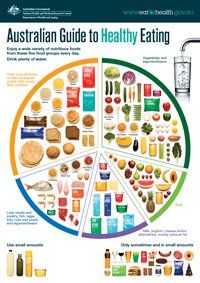Nurturing Health and Wellbeing with the Australian Guide to Healthy Eating
Nurturing Health and Wellbeing with the Australian Guide to Healthy Eating

The Australian Guide to Healthy Eating (AGHE) is a pivotal resource developed to support Australians in making healthier food choices. It offers comprehensive, evidence-based guidance on achieving a balanced diet, which is essential for maintaining good health and wellbeing. Let's explore the principles and the immense value of this guide for promoting a healthier lifestyle.
Principles of the Australian Guide to Healthy Eating
The AGHE is built on several core principles that align with the Australian Dietary Guidelines (ADGs). These principles are designed to help individuals make informed decisions about their dietary habits:
1. Balanced Diet from Five Food Groups:
- The AGHE emphasizes the importance of consuming a variety of foods from the five food groups: vegetables and legumes/beans, fruits, grains (mostly wholegrain), lean meats and poultry, fish, eggs, tofu, nuts and seeds, and dairy (or alternatives).
- Each group offers unique and essential nutrients, ensuring a well-rounded intake of vitamins, minerals, and other vital compounds necessary for good health.
2. Portions and Moderation:
- The guide illustrates the recommended portions of each food group through a visual representation known as the “Australian Guide to Healthy Eating plate.” This plate shows the ideal balance between different food types, helping individuals understand portion sizes and the importance of moderation.
- It also advocates for limiting foods high in saturated fat, added salt, and sugars, which can contribute to chronic diseases.
3. Hydration:
- The AGHE highlights the importance of drinking plenty of water as part of a healthy diet. Staying hydrated is crucial for various bodily functions, including digestion, temperature regulation, and cognitive performance.
4. Safety and Sustainability:
- Emphasizing food safety practices to prevent foodborne illnesses.
- Encouraging sustainable food choices to protect the environment and ensure food security for future generations.
Value for Health and Wellbeing
The AGHE provides a roadmap to healthier eating habits, leading to numerous benefits for both physical and mental wellbeing:
1. Nutrient Sufficiency:
- Following the AGHE ensures that individuals get the essential nutrients required for optimal body function. This includes vitamins, minerals, protein, fiber, and healthy fats, which collectively support growth, immunity, and overall health.
2. Chronic Disease Prevention:
- Adhering to the guide's recommendations can significantly reduce the risk of chronic diseases such as heart disease, type 2 diabetes, obesity, and certain cancers. By promoting a diet rich in fruits, vegetables, whole grains, and lean proteins, the AGHE helps combat the common risk factors associated with these conditions.
3. Weight Management:
- The balanced and proportionate approach advocated by the AGHE aids in maintaining a healthy weight. It encourages portion control and mindful eating, which are crucial for preventing overweight and obesity.
4. Mental Health Benefits:
- A nutritious diet is closely linked to improved mental health. The AGHE's emphasis on whole, nutrient-dense foods supports brain health, reducing the risk of mental health issues like depression and anxiety.
5. Improved Quality of Life:
- Good nutrition enhances overall quality of life by boosting energy levels, improving mood, and enhancing physical performance. The AGHE promotes a holistic approach to eating that considers not just physical health, but overall wellbeing.
6. Educational Value:
- The AGHE serves as an educational tool for individuals, families, and communities. It empowers people with the knowledge to make healthier food choices and understand the long-term benefits of a balanced diet.
Conclusion
The Australian Guide to Healthy Eating is more than just a dietary framework; it's a cornerstone for building a healthier future. By adhering to its principles, Australians can enjoy a balanced, nutrient-rich diet that supports their physical, mental, and emotional wellbeing. Embracing the AGHE's recommendations can lead to a healthier population, reduced healthcare costs, and a better quality of life for everyone.







